Overview
2005 proved to be one of the most volatile years in the futures markets in recent history and surprised many analysts by showing persistent strength in many expanding commodity markets. Typical of historical bull cycles in commodities, volatility and price action far exceed many traders? expectations. However, unlike previous bull cycles the influx of foreign speculators, hedge funds, managed funds and general speculators drawn in by the growing acceptance and attention of the financial industry and decline in the interest of stock market participation has created massive changes in the price action of many of the major commodities. Moreover, the advent of improving technologies and the stabilization of the integrity of the exchanges and futures markets themselves (mainly due to increasing global market competition and online efficiency) has created an added incentive for outside participation in what has long been an insiders market. This trend is most evident in the expansion of the managed futures market which has had explosive growth in a very short time frame ? both from the perspective of dollars invested and quantity of funds available. This is reminiscent of the metamorphic rise of mutual funds in the stock market in the 90s.
This expansion will force traders to acknowledge a new aspect of price action in commodities, one not so different from that of electronic buy/sell programs implemented by large funds in the stock market. Earlier in the year there was growing interest in the grain markets as outside institutional investors were developing large diversified positions in what many saw as an undervalued market condition and an opportunity to invest in growing demand from China?s explosive economy. The mere rumor of this surged soybean and grain prices during a seasonally strong period and the underlying investment by these in funds paled in comparison to the psychological momentum this created in the market.
Of course, no one will forget the surge in energy prices this year, spurred on by a fundamental shortage and hurricanes. However, more in-depth analysis would suggest market pundits like Jim Rogers and 24/7 coverage on CNBC led the sector into hysteria buying. Back in February crude oil was up some 22 out of 26 trading days, and in August it had a similar run ? a clear sign of market hysteria and short covering surges that would lead to an inevitable decline. Nevertheless, the market surged further when Katrina offered a fundamental catastrophe and, as often happens in market conditions such as these, gave us the eventual top in the market. You can certainly identify moves like this throughout our history, but an objective evaluation would tell you the bulk of this move occurred on the expanding coverage and PR that the commodities sector is getting in the financial industry. And this is just the beginning?
Energies
After a year in which we witnessed a squeeze, shortage, spiked demand, terrorist attacks on oil fields, war in the middle east, price gauging, several natural disasters and the release of the US oil reserves the crude market nearly doubled in price, while unleaded gas, heating oil, and natural gas nearly tripled. Moreover, the daily volatility and peak prices all reached all-time highs.
Fundamentally, the market has been given a critical warm winter time frame to catch up on trailing seasonal inventories, giving the market a possible hedge against the upcoming hurricane season. While the market will build a significant premium into the ?06 hurricane season, it appears fundamentally the market may offer some price relief ahead of the shifting seasonal market. No longer is seasonal demand the main focus in the energy complex, but rather seasonal supply concerns will take center stage. This means that buying unleaded gas in April and May and heating oil and natural gas in July and August will force seasonal traders to get in prematurely to historic seasonal entry time frames. With natural gas holding onto historic extreme highs, the weekly Wednesday oil inventory report will have less and less impact as natural gas inventory data on Thursday will take on the main focal point for traders looking to supply sensitivity. Overall, the weather market will overtake the supply data and OPEC influences in regards to market moving information.
Technically, the unleaded gas, crude and heating oil markets all have nearly identical intermediate and long term chart formations. They all sit on critical trend line support on a weekly chart and hold a steep uptrend on a monthly chart. On a shorter term view the market appears to be trying to find support in a mild down trending channel and lacks momentum to suggest the market will breakdown significantly. Throw in a delayed cold weather reaction and the market is setting up for a bull spike in January before failing to fresh lows ahead of April/May pre-hurricane season buying. If the weekly trend line support is broken this market takes on a severe bearish technical outlook, but until that occurs the trend line is strong enough to suggest the market will support out and offer a rally in the short term.
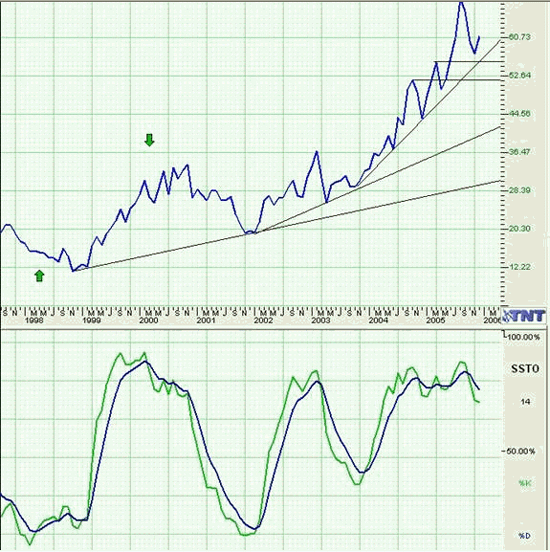
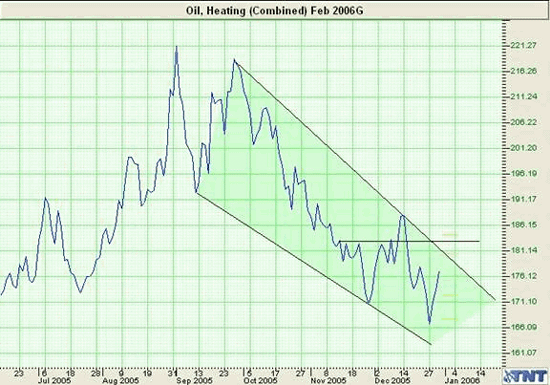
Natural gas has diverged as the market with the greatest volatility and weather/inventory sensitivity. If the trend line holds in crude I would expect to see a test of the recent highs but ultimately give the natural gas market a critical top before a complete collapse takes place. This market extreme has a very limited time frame to hold up. The monthly technical view on the market shows a similar pattern to what was seen in late ?04 and suggests that while a very large price range exists for the market to retrace, that we will likely see a choppy sideways support in the next few months.
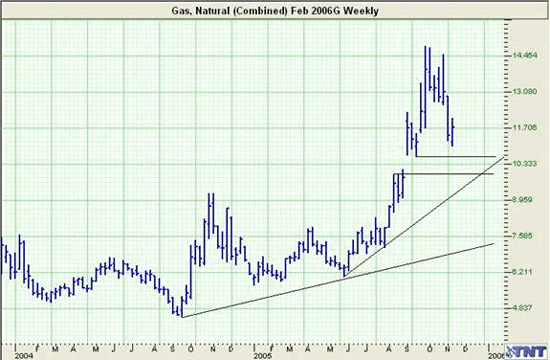
Overall, I highly recommend selling call premium in all energy complexes, 4-8 weeks out in time with a 15-20% OTM target in crude, heat and unleaded, and a 50% OTM target in natural gas. Wait for $1-$2 price spikes in crude (within a 3 day time frame), proportionate moves in heating oil and unleaded gas and a $1 move in natural gas before entering into the short calls.
Financials
A sideways year in the stock market was made even more avoidable as we were forced to watch one technical break and failure after another. The stock market offered no follow through, little volatility and ultimately no price movement. I see very little to change this market in ?06.
Fundamentally this market has a likely poor performance year ahead, but also has declining expectations from analysts to help the market create a balance between expectations and performance. This sets the stage for a bull market if the market can step up and outperform the analysts. However, a more likely scenario is one that meets analysts views and give stock bulls little to push the market to significant new highs.
Technically, this choppy market retraced enough to end ?05 that the January selloff we saw earlier this year will not likely occur with the same ferocity this year. Historically, January money flow gives buying volume to support post New Year rallies. However, there are two critical shifts in investment world that suggests this trend is no longer. Both an investment shift to real estate and commodities for money managers and private investors limits the money flow. Second, investor hesitation will likely create a delayed reaction in retirement funding and implementation into the U.S. stock market. With global funds offering strong performance by comparison to the U.S. stock market in ?05 we will likely see more widespread asset diversification.
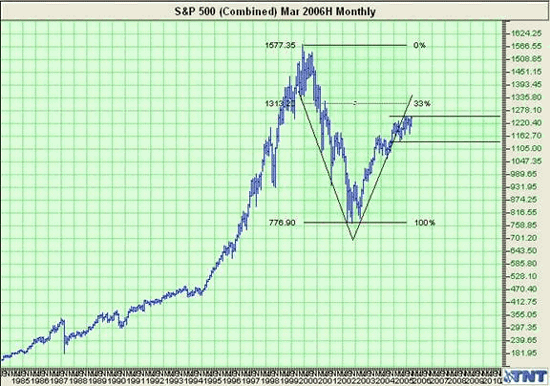
The bond market is fundamentally and technically at a major consolidation point heading into the New Year and has all the telltale signs of a market about to explode with volatility and a technical price expansion.
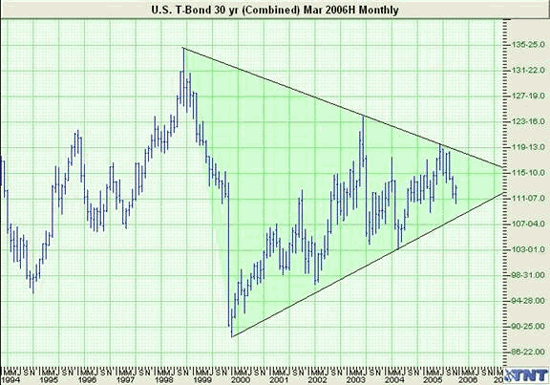
As Greenspan steps aside and Bernanke steps in many feel the Fed will not skip a beat, but I suspect Bernanke will take on the job as if it is a new regime and a new philosophy that will mark his tenure. He is not afraid to rock the boat and the tension and volatility this shift will create will be much more significant than many expect. Moreover, as the Fed nears a critical shift in interest rate policy, the market will need to take on a more long term trend view, leading to more volatility and short term price trending then we witnessed in ?05.
Technically, the bond and note market is approaching the tip of a long term pennant formation, suggesting the consolidating has come to a head and a technical price expansion is likely to occur in the next 2-6 weeks. This price move will likely carry bonds to either 120 or 110. The gut says to develop bear put spreads and be a buyer of straight OTM puts as a move below 110 should occur as foreign buying diminishes and selling pressure comes on the flood of volume from the reintroduction of the 30 yr.
The US dollar played along with my forecast throughout much of ?05, and stayed range bound through the later half of the year while simultaneously staying near the year?s high as we head into ?06. The dollar has a several year trend history that suggests we are at the just the beginning of a US dollar bull run.
Fundamentally, treasury secretary Snow made it clear the once ridiculous philosophy of let the free market determine US dollar value is no longer. Whether it was clear to all or not it was clear to me that the Bush administration, the Fed and Snow all want a strong dollar policy moving forward. It took 7 years to get to 120 from 80, and three years to take it back. I suspect the trend will be much more measure and paced at a rate that lends itself to a target of par on the index by the end of ?06.
Technically, the US dollar enters ?06 ready to set fresh highs, but lacking any real momentum. My gut says wait for a break to about 94 and then buy the euro. All the way around the currency spectrum I see overpriced premiums developing the first few months of the year, which means long strangles from in January and February.
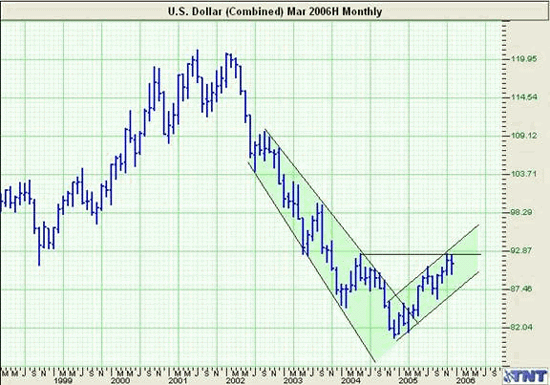
The Canadian dollar had a stellar uptrend, making bears like myself get involved in a futile relationship with a currency that has increasingly become commodity sensitive. I suspect this overbought market is nearing the point of exhaustion and could easily see a significant retracement in 2006. I recommend developing bear plays immediately, with a scale in approach that allows for a difficult to time market to eventually hit a price retracement target of 8050 before the year is out.
The Japanese yen is oversold but has little to suggest that fundamentally and technically the market should rally. The Japanese government relies on exports to survive as an economy, and a weak currency allows for a strong export market.
Grains
The grain market enters 2006 with declining concerns over rust fungus, a lack of demand from China and a shifting cyclical planting issue that has brought soybeans to the supply forefront. I believe the price support levels we are currently seeing are near the lows this market sector will see in ?06, but the lack of bullish fundamentals needs to shift in order to change the longer term trend. I view the grain market as one in which the bad news is out and the market can only rise from here.
However, a good crop in ?06 is still a good crop and a bad crop is still a bad crop and that will be the bottom line. Grains should fall back into a seasonally predictable market and I would use the current rally (if you can call it that) as a gauge for bottom price support for the year. Therefore, look to be a buyer in late May if the market gets a good 10% bounce early, as I would suspect planting data would then bring the market lower and only a weather related run in the summer will get this market into bull mode. Corn is fighting off a lot of fundamentals that suggest a lower price support line developing for years to come. Beans are being planted everywhere while demand remains a big unknown, while foreign demand for wheat and a shift in supply might make it the market of choice in this sector for ?06. Rough Rice continues to scream bull market and I would look for an early breakout in ?06. Oats erratic behavior and declining market interest makes this a market to ignore.
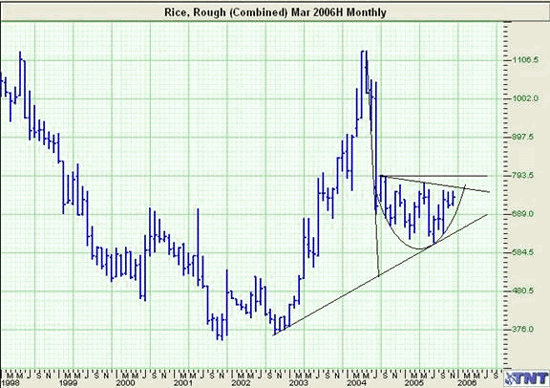
Meats
Back when Atkins became the main thrust behind a new price zone theory in cattle I was more than a bit suspect. Then mad cow hit and Japan started the bans on US and Canadian beef that put supply issues all over the map. Cash prices largely supported the market and speculators helped push a short covering rally that ended cattle?s year pushing a technical zone that only offered historical resistance at the all time highs. Nevertheless, this market screams shifting fundamentals and ?06 gives us bears a fresh leaf to play a bear breakdown in a market that has been floating at extreme prices for far too long. This overbought market condition should find resistance developing at current prices and a strong reversal taking place in the first quarter of 2006. Buying straight OTM puts, bear put spreads or synthetic shorts with April spreads about 5% away from the market are great plays on this market.
Hogs gave been in a solid sell structure for the better part of six months, but find itself on the edge of support and a pennant formation that goes back several years. On a shorter term view this market is about to expand its range as the consolidation ranges across all time frames and suggests a counter trend spike before a collapse. However, if the market sets a new low on a monthly I would watch out as a collapse could be in the making. This is one of the best setups for a long strangle I have seen in a while. Feb options about 6-7% OTM would be a great low cost, low risk and high reward play.
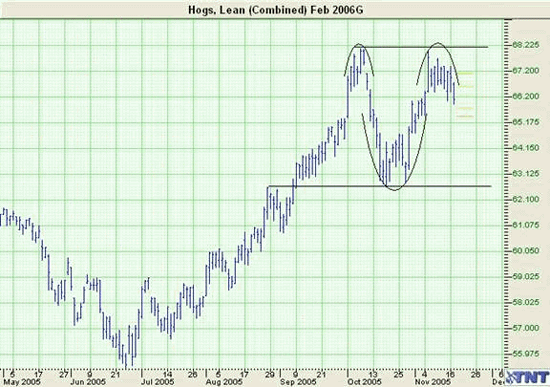
Metals
2005 was the year of the worst market call of my career and it found its home in the gold market. While most traders are of the ?what have you done for me lately? mentality, I hope there are readers who remember the nearly 2 years of my analysis being a step ahead of this market in my reports and recommendations. Moreover, the recommendations in the gold market, as I acknowledged I was fighting the trend, was mainly buying cheap OTM puts to play potential spikes in volatility to the downside. This is one of the few ways I would feel comfortable standing in front of a steaming locomotive heading to multi-decade highs. The gold market surged despite a strong US dollar, and the dollar was the basis for anticipating a retracement in gold. This most recent leg up to fresh highs in gold and the continued expectation for strength in the dollar leads me to continue to fight the trend in ?06. The correlative principals that connect the dollar to gold are undeniable, but a market can, and historically has, run free of its intermarket or cross-fundamental correlations for a brief period of time. However, when these forces go to such extremes as the gold/dollar relationship, and other correlative inflation indicating markets like oil and bonds do not explain the movement, then the relationship will almost inevitably come back into alignment over time. A gold retracement from these price levels could be historic in its magnitude and ferocity.
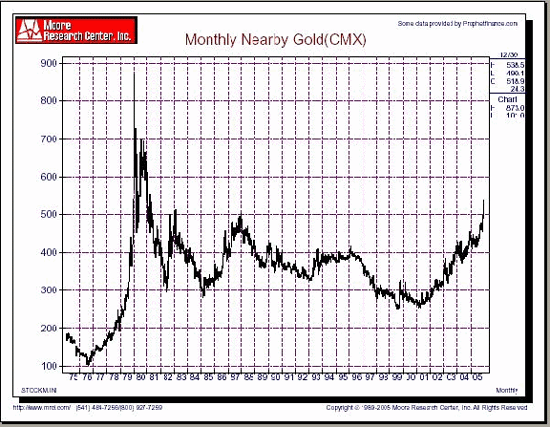
Silver ratio credit call spreads remain solid premium collection plays as underlying volatility in silver remain at significant highs on 15 cent more rally days. Silver as a whole lacks the short covering momentum and the disappearance of sellers we saw that brought the market to these levels in the first place. Buying puts here is also recommended as an aggressive complement to a ratio credit call spread strategy.
Copper remains at extreme levels as foreign demand and an expanded use market has propelled copper to nearly quadruple its levels of 2002. Technically there is little to be bearish about, and the risk exposure of any short futures play is likely not worth the risk. Fundamentally the market is due to see some relief in the supply/demand equation, but to what degree has the market priced this in? Given the potential for major volatility spikes to the downside I recommend being a buyer of straight deep OTM puts and selling deep OTM call premium should the opportunity present itself.
Palladium spiked off of significant value lows and has reemerged as a strengthening market. However, as the metals complex climate gets more volatile I am inclined to stand aside despite my bullish views here.
Platinum remains overbought and due for a significant correction in 2006.
Softs
Orange juice has seen a doubling of price in under a year and a half as hurricane destruction in Florida along with Cankor fungus has devastated the once largest producer of orange juice in the world. Brazil production is questionable as well and overall this market is not only bullish but in a new dimension of trading. Not only are traders concerned about traditional frost season worries, but now they have a whole hurricane season to fear. About 2/3rds of the year the market is in weather panic ? this is no small shift in trading mentality. This will likely force the market to maintain substantial premium throughout those seasonal periods. I am a buyer on any price dips below $1.
Coffee developed a short supply squeeze rally earlier this year, as what some insiders saw as a global third world collusion effort. The last several months found a true lack of price trending and technically offered several support and resistance points to develop a level of consolidation that screams bull breakout in ?06. You can?t ignore the historical relevance of the last two and only two times coffee prices have been below $.50/lb. Both times we saw a quadrupling of price before the run was over, and this time we are seeing the market meander around a $1 and taking far more time to accomplish the same feat. The reason this is so significant is that extremes in markets that have third world supply cycles tend to offer opposite extremes because growers tend to over-exaggerate the supply to compensate for those price shifts. This time around there is a changing dynamic. No longer is South America the producer of coffee it once was. The #2 is now Vietnam and Thailand and Mexico are fast becoming major influences in the coffee supply world. This global shift makes the cyclical changeover that should have brought about the extreme rally not so extreme. Overall the market remains bullish, but that cyclical pattern that brought a bunch of spec players like myself into the game is not there anymore.
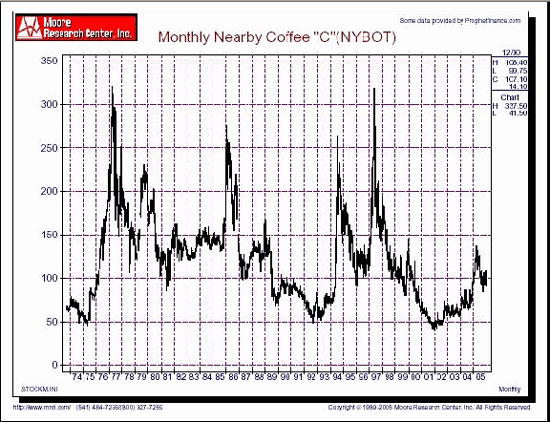
Cocoa should have had an expansive year in 2005 in both price and volatility, but found itself range bound for much of the year. When the Ivory Coast, that produces about 2/3rds of the world?s supply, was overtaken by France, went through election mishaps and was exposed to multiple coup attempts, you would have thought a cocoa rally was a foregone conclusion. Now, as the market surges to end the year, we may finally see a price breakout and a big year ahead in cocoa. Calls remain inexpensive despite price levels and volatility expansion around the corner.
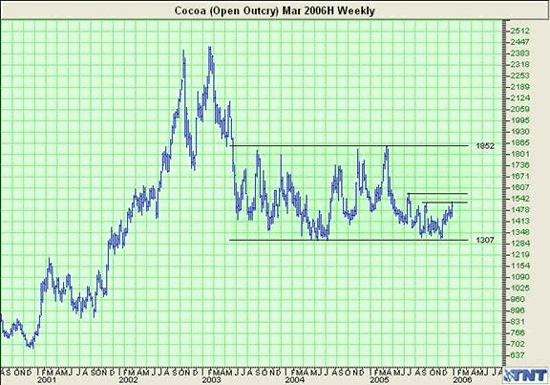
The cotton market spent ?05 in a depressed mode, unable to establish a true bottom and also lacking the momentum to rally. This market is technically in need of a major breakdown to establish a low and cyclical turn that will force production to reverse and the supply situation to force a rally. This is a couple of years out and the market, in the meantime, will likely find itself attempting to set fresh lows. Fundamentally this market suffers from an abundance of supply and only weather will bail this market out of this situation. Look to buy inexpensive put options and avoid selling call premium as exposure to the upside is not worth the pitiful premiums given the dying volatility.
Sugar was perhaps the biggest underdog story of 2005 as it surged to levels not seen in over a decade, making this market nearly triple its price of just 2 years ago. Jim Rogers and George Bush should be thanked for their contribution as the energy crisis has brought many speculators to sugar because of its ability to be used in the production of ethanol. Nevertheless South America, and in particular Brazil have shifted its production efforts to sugar to benefit from the expanding price. Sugar production is cheap, easy and plentiful. This rally was based on part fear, part long term reality and part good PR that a demand surge was in the making. Sugar is at a critical price level. Sugar has not been above 16 & ? cents in almost 25 years, and offered three critical tops just above 15 cents during that time. This market should be aggressively shorted by buying inexpensive leveraged deep OTM put options with a ton of time on them ? look at July 12 cent puts for $300. If the market breaks thoroughly through 16 & ? cents then the skies the limit, but otherwise this is a fairly predictable top in a market that is extremely overbought and overdue for a correction.
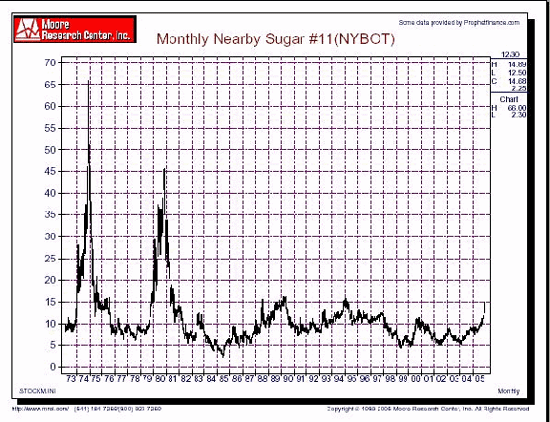
Lumber remains in the middle of long term support and resistance bands and lacks a fundamental or technical directional trend worth looking at. I would look to be a seller near 400, a buyer near 240 and avoid anywhere in the middle. The housing market is not the focal point of lumber prices as much as it used to be, as new home construction is dwindling and the focus turns more to the natural disaster issues that is fast becoming the focal point of many commodity markets. Look to be a seasonal buyer of lumber in May if prices get below 300.
Disclaimer
There is risk of loss in all commodities trading. Commissions and fees vary per individual and therefore are not included in profit, cost and risk scenarios. Please consult a licensed broker before you trade for the first time. Losses can exceed your account size and/or margin requirements. Commodities trading can be extremely risky and is not for everyone. Some option strategies have unlimited risk. Educate yourself on the risks and rewards of such investing prior to trading. James Mound Trading Group, or anyone associated with JMTG or moundreport.com, do not guarantee profits or pre-determined loss points, and are not held monetarily responsible for the trading losses of others (clients or otherwise). Past results are by no means indicative of potential future returns.
James Mound is owner of JMTG Brokerage LLC, and author of the book 7 Secrets. To subscribe to James Mound's trade recommendation service or for more information, please visit www.MoundTradeSignals.com.